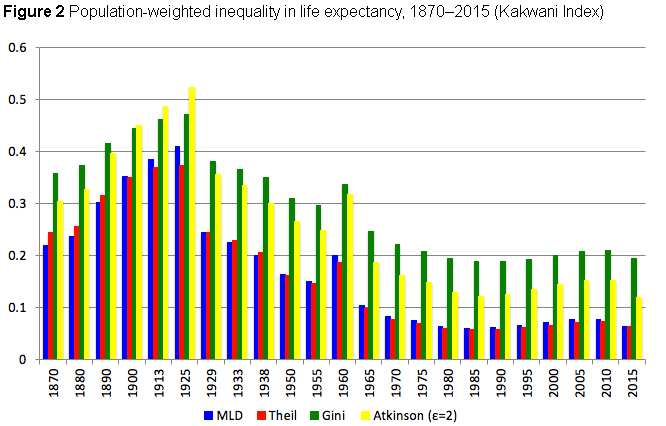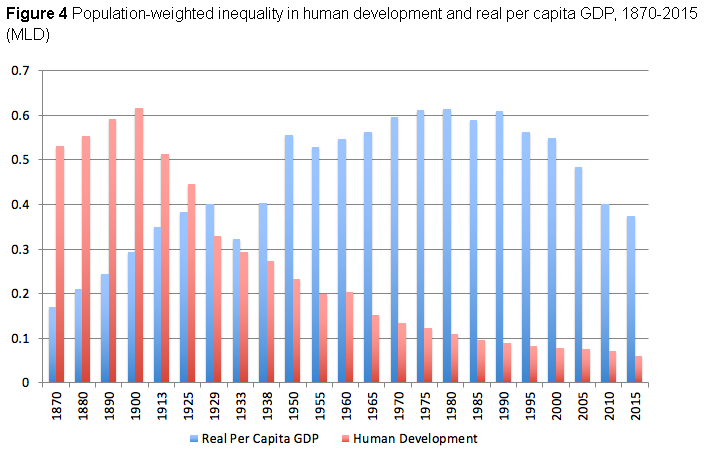 Women worldwide tend to be more religious than men. In the United States, for example, self-identified Christian women are more religious than self-identified Christian men.[ref]However, it’s the opposite in Israel among Jews.[/ref] Numerous possible reasons have been offered, from the social to the genetic. Last year, I highlighted a study that found religion to be less analytical and more pro-social: “In a series of eight experiments, the researchers found the more empathetic the person, the more likely he or she is religious. That finding offers a new explanation for past research showing women tend to hold more religious or spiritual worldviews than men. The gap may be because women have a stronger tendency toward empathetic concern than men.” As noted by economist Bryan Caplan, “Stereotypes about personality and gender turn out to be fairly accurate: on both Myers–Briggs thinking–feeling and FFM agreeableness, there are large male–female gaps in the expected directions. Women are about half a standard deviation more agreeable than men; on the binary Myers–Briggs measure, the thinking–feeling breakdown is about 30/70 for women versus 60/40 for men.”[ref]Caplan, “Stigler Becker versus Myers-Briggs: Why Preference-Based Explanations Are Scientifically Meaningful and Empirically Important,” Journal of Economic Behavior & Organization 50 (2003): 400.[/ref] According to Pew,
Women worldwide tend to be more religious than men. In the United States, for example, self-identified Christian women are more religious than self-identified Christian men.[ref]However, it’s the opposite in Israel among Jews.[/ref] Numerous possible reasons have been offered, from the social to the genetic. Last year, I highlighted a study that found religion to be less analytical and more pro-social: “In a series of eight experiments, the researchers found the more empathetic the person, the more likely he or she is religious. That finding offers a new explanation for past research showing women tend to hold more religious or spiritual worldviews than men. The gap may be because women have a stronger tendency toward empathetic concern than men.” As noted by economist Bryan Caplan, “Stereotypes about personality and gender turn out to be fairly accurate: on both Myers–Briggs thinking–feeling and FFM agreeableness, there are large male–female gaps in the expected directions. Women are about half a standard deviation more agreeable than men; on the binary Myers–Briggs measure, the thinking–feeling breakdown is about 30/70 for women versus 60/40 for men.”[ref]Caplan, “Stigler Becker versus Myers-Briggs: Why Preference-Based Explanations Are Scientifically Meaningful and Empirically Important,” Journal of Economic Behavior & Organization 50 (2003): 400.[/ref] According to Pew,
Under the “nature” umbrella are theories that variously attribute gender differences in religious commitment to physical or physiological causes such as hormones, genes or biological predispositions.
For example, Baylor University sociologist Rodney Stark postulates that men’s physiology – specifically their generally higher levels of testosterone – accounts for gender differences in religion. His argument rests on what he views as increasing evidence that testosterone is associated with men’s greater propensity to take risks, which he argues is why men are less religious than women. By inference, women are more religious because they have less risk-promoting testosterone.
A new study offers some evidence for the testosterone theory:
From the analysis of over 1000 men, [Aniruddha] Das found that men with higher levels of the sex hormones testosterone and dehydroepiandrosterone (DHEA) in their bodies had weaker religious ties.
“Religion influences a range of cultural and political patterns at the population level. Results from the current study indicate the latter may also have hormonal roots,” says Das. “There is therefore a need for conceptual models that can accommodate the dynamic interplay of psychosocial and neuroendocrine factors in shaping a person’s life cycle.”
He believes that more studies should be done to better understand how hormones, in particular, shape a person’s religious patterns in later life. This is of importance, as religion has been shown to have a positive influence on how people age and ultimately experience their later years. According to Das, the findings further point to biological reasons behind the particular personal networks and social affiliations that people form during the course of their lives.
Testosterone has been shown to reduce empathy, perhaps explaining why women tend to be more empathetic–and therefore, more religious–than men. As Steven Pinker explains, “Women have more intimate social relationships, are more concerned about them, and feel more empathy toward their friends, though not toward strangers.”[ref]The Blank Slate, pg. 345. This is why men suffer more from loneliness. See Thomas Joiner, Lonely at the Top: The High Cost of Men’s Success (New York: St. Martin’s Press, 2011).[/ref]
It’ll be interesting to see what future research finds.






 Lawrence M. Krauss, A Universe From Nothing: Why There Is Something Rather Than Nothing (Free Press, 2012): “Bestselling author and acclaimed physicist Lawrence Krauss offers a paradigm-shifting view of how everything that exists came to be in the first place. “Where did the universe come from? What was there before it? What will the future bring? And finally, why is there something rather than nothing?” One of the few prominent scientists today to have crossed the chasm between science and popular culture, Krauss describes the staggeringly beautiful experimental observations and mind-bending new theories that demonstrate not only can something arise from nothing, something will always arise from nothing. With a new preface about the significance of the discovery of the Higgs particle, A Universe from Nothing uses Krauss’s characteristic wry humor and wonderfully clear explanations to take us back to the beginning of the beginning, presenting the most recent evidence for how our universe evolved—and the implications for how it’s going to end. Provocative, challenging, and delightfully readable, this is a game-changing look at the most basic underpinning of existence and a powerful antidote to outmoded philosophical, religious, and scientific thinking” (
Lawrence M. Krauss, A Universe From Nothing: Why There Is Something Rather Than Nothing (Free Press, 2012): “Bestselling author and acclaimed physicist Lawrence Krauss offers a paradigm-shifting view of how everything that exists came to be in the first place. “Where did the universe come from? What was there before it? What will the future bring? And finally, why is there something rather than nothing?” One of the few prominent scientists today to have crossed the chasm between science and popular culture, Krauss describes the staggeringly beautiful experimental observations and mind-bending new theories that demonstrate not only can something arise from nothing, something will always arise from nothing. With a new preface about the significance of the discovery of the Higgs particle, A Universe from Nothing uses Krauss’s characteristic wry humor and wonderfully clear explanations to take us back to the beginning of the beginning, presenting the most recent evidence for how our universe evolved—and the implications for how it’s going to end. Provocative, challenging, and delightfully readable, this is a game-changing look at the most basic underpinning of existence and a powerful antidote to outmoded philosophical, religious, and scientific thinking” ( Daniel M. Cable, Alive at Work: The Neuroscience of Helping Your People Love What They Do (Harvard Business Review Press, 2018): “In this bold, enlightening book, social psychologist and professor Daniel M. Cable takes leaders into the minds of workers and reveals the surprising secret to restoring their zest for work. Disengagement isn’t a motivational problem, it’s a biological one. Humans aren’t built for routine and repetition. We’re designed to crave exploration, experimentation, and learning–in fact, there’s a part of our brains, which scientists have coined “the seeking system,” that rewards us for taking part in these activities. But the way organizations are run prevents many of us from following our innate impulses. As a result, we shut down. Things need to change. More than ever before, employee creativity and engagement are needed to win. Fortunately, it won’t take an extensive overhaul of your organizational culture to get started. With small nudges, you can personally help people reach their fullest potential. Alive at Work reveals:
Daniel M. Cable, Alive at Work: The Neuroscience of Helping Your People Love What They Do (Harvard Business Review Press, 2018): “In this bold, enlightening book, social psychologist and professor Daniel M. Cable takes leaders into the minds of workers and reveals the surprising secret to restoring their zest for work. Disengagement isn’t a motivational problem, it’s a biological one. Humans aren’t built for routine and repetition. We’re designed to crave exploration, experimentation, and learning–in fact, there’s a part of our brains, which scientists have coined “the seeking system,” that rewards us for taking part in these activities. But the way organizations are run prevents many of us from following our innate impulses. As a result, we shut down. Things need to change. More than ever before, employee creativity and engagement are needed to win. Fortunately, it won’t take an extensive overhaul of your organizational culture to get started. With small nudges, you can personally help people reach their fullest potential. Alive at Work reveals: Newell G. Bringhurst, Saints, Slaves, & Blacks: The Changing Place of Black People Within Mormonism, 2nd ed. (Greg Kofford Books, 2018): “Originally published shortly after the LDS Church lifted its priesthood and temple restriction on black Latter-day Saints, Newell G. Bringhurst’s landmark work remains ever-relevant as both the first comprehensive study on race within the Mormon religion and the basis by which contemporary discussions on race and Mormonism have since been framed. Approaching the topic from a social history perspective, with a keen understanding of antebellum and post-bellum religious shifts, Saints, Slaves, and Blacks examines both early Mormonism in the context of early American attitudes towards slavery and race, and the inherited racial traditions it maintained for over a century. While Mormons may have drawn from a distinct theology to support and defend racial views, their attitudes towards blacks were deeply-embedded in the national contestation over slavery and anticipation of the last days. This second edition of Saints, Slaves, and Blacks offers an updated edit, as well as an additional foreword and postscripts by Edward J. Blum, W. Paul Reeve, and Darron T. Smith. Bringhurst further adds a new preface and appendix detailing his experience publishing Saints, Slaves, and Blacks at a time when many Mormons felt the rescinded ban was best left ignored, and reflecting on the wealth of research done on this topic since its publication” (
Newell G. Bringhurst, Saints, Slaves, & Blacks: The Changing Place of Black People Within Mormonism, 2nd ed. (Greg Kofford Books, 2018): “Originally published shortly after the LDS Church lifted its priesthood and temple restriction on black Latter-day Saints, Newell G. Bringhurst’s landmark work remains ever-relevant as both the first comprehensive study on race within the Mormon religion and the basis by which contemporary discussions on race and Mormonism have since been framed. Approaching the topic from a social history perspective, with a keen understanding of antebellum and post-bellum religious shifts, Saints, Slaves, and Blacks examines both early Mormonism in the context of early American attitudes towards slavery and race, and the inherited racial traditions it maintained for over a century. While Mormons may have drawn from a distinct theology to support and defend racial views, their attitudes towards blacks were deeply-embedded in the national contestation over slavery and anticipation of the last days. This second edition of Saints, Slaves, and Blacks offers an updated edit, as well as an additional foreword and postscripts by Edward J. Blum, W. Paul Reeve, and Darron T. Smith. Bringhurst further adds a new preface and appendix detailing his experience publishing Saints, Slaves, and Blacks at a time when many Mormons felt the rescinded ban was best left ignored, and reflecting on the wealth of research done on this topic since its publication” ( Benjamin Powell, Out of Poverty: Sweatshops in the Global Economy (Cambridge University Press, 2014): “This book provides a comprehensive defense of third-world sweatshops. It explains how these sweatshops provide the best available opportunity to workers and how they play an important role in the process of development that eventually leads to better wages and working conditions. Using economic theory, the author argues that much of what the anti-sweatshop movement has agitated for would actually harm the very workers they intend to help by creating less desirable alternatives and undermining the process of development. Nowhere does this book put ‘profits’ or ‘economic efficiency’ above people. Improving the welfare of poorer citizens of third world countries is the goal, and the book explores which methods best achieve that goal. Out of Poverty will help readers understand how activists and policy makers can help third world workers” (
Benjamin Powell, Out of Poverty: Sweatshops in the Global Economy (Cambridge University Press, 2014): “This book provides a comprehensive defense of third-world sweatshops. It explains how these sweatshops provide the best available opportunity to workers and how they play an important role in the process of development that eventually leads to better wages and working conditions. Using economic theory, the author argues that much of what the anti-sweatshop movement has agitated for would actually harm the very workers they intend to help by creating less desirable alternatives and undermining the process of development. Nowhere does this book put ‘profits’ or ‘economic efficiency’ above people. Improving the welfare of poorer citizens of third world countries is the goal, and the book explores which methods best achieve that goal. Out of Poverty will help readers understand how activists and policy makers can help third world workers” (



